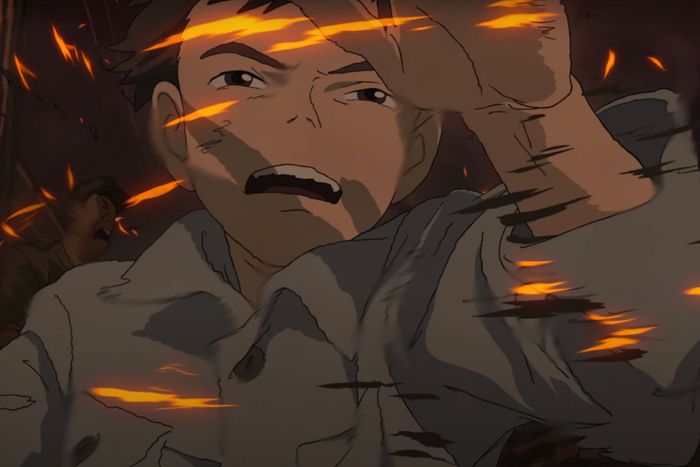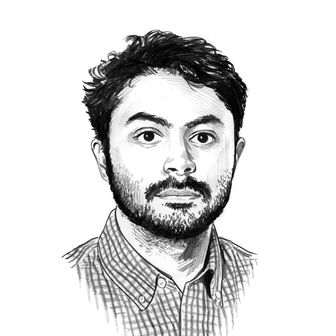
This article was originally published on December 8, 2023. The Boy and the Heron is now available to stream on Max.
The Boy and the Heron, the newest film by Studio Ghibli director Hayao Miyazaki, opens with an unforgettable sequence of war and violence that’s visually darker and grimmer than any in his filmography: The year is 1943, and Miyazaki’s young hero, Mahito, throws on his clothes and races through a Tokyo on fire in search of his mother. Miyazaki enlisted a frequent collaborator, the artist Shinya Ohira, to animate Mahito’s path through the inferno. As Mahito elbows through crowds and wrecked streets, both he and the civilians around him stretch, twist, and fragment — their intentionally broken character models conveying Mahito’s mounting desperation and disorientation amid the smoke.
The scene feels like one of the most starkly autobiographical elements of The Boy and the Heron, much of which spilled from Miyazaki’s lived experience. “My first memories are of bombed-out cities,” Miyazaki, born in 1941, writes in his interview compilation, Starting Point. Miyazaki’s mother, like Mahito’s, gifted her young son a copy of Genzaburo Yoshino’s instructional coming-of-age novel How Do You Live? — four words that serve both as the film’s existential prompt and its title in Japan. Concern for Miyazaki’s mother loomed over his childhood as she was hospitalized with a form of tuberculosis and nursed at home for years; anguish over Mahito’s mother casts a similar shadow through his. But the autobiography in The Boy and the Heron only goes so far: Mahito’s mother dies in that scene, consumed by hellfire before the boy can reach her, while Miyazaki’s mother lived until 1983, long enough to know the beginnings of her son’s storied animation career.
The word semi-autobiographical can hold a certain promise to moviegoers, and the hype around Miyazaki’s first film in a decade has fully embraced it; it’s all over the reviews and press materials and, to be fair, the film hardly hides its real-life connections to the director’s life. But anyone who’s followed Miyazaki’s work attentively could recognize those connections in the rest of his movies, too. In My Neighbor Totoro, the mother of two young girls is also hospitalized and bedridden. In The Castle of Cagliostro, the director animated Arsène Lupin III driving a Citroen, the same car Miyazaki drove for decades. In The Wind Rises, his last “last” movie, the protagonist designs Japanese fighter planes, mirroring the life of Miyazaki’s father (and Mahito’s) and his own obsession with flight. (Wartime planes appear throughout Porco Rosso, too, where the titular pig flies one emblazoned with the word Ghibli.) In Kiki’s Delivery Service, Miyazaki introduces themes of loneliness and frustration to a story he adapted, expressing his creative crankiness documented in films like The Kingdom of Dreams and Madness — iconically: “Filmmaking only brings suffering.” Describing any of those films as “semi-autobiographical” feels almost redundant: Like most artists, Miyazaki cannot help but insert himself. What’s most interesting about his newest film, though, is that his characters comment on that creative connection more openly than ever before. The mendacious Gray Heron lures Mahito into a dreamlike world with the possibility of bringing back his deceased mother. Miyazaki presents the boy’s choice in that moment as an inevitability: “I know it’s a lie, but I have to see,” he says before plunging in. The scene brings to mind the way Miyazaki cannot resist animating his personal history. Nothing will stop the now-82-year-old filmmaker from dying, but his drive to create remains irrepressible, even “never-ending.” It’s what yanked him out of retirement yet again to create this hallucinatory parable for reckoning with grief and mortality.
Mahito’s acceptance of the Heron’s constant lies also hearkens back to one of Miyazaki’s decades-old contemplations on his own creative process. Like the Heron, he doesn’t necessarily see falsehoods as all bad. “The animator must fabricate a lie that seems so real viewers will think the world depicted might possibly exist,” he wrote in a 1979 picture book, excerpted in Starting Point. An animated “lie” must be told with an attention to realism, especially in action — from the way Prince Ashitaka strains to restring his bow in Princess Mononoke to how Chihiro taps her shoes in place in Spirited Away. Behaviors like these — which Guillermo del Toro, a Miyazaki devotee, calls “unnecessary gestures” — might seem extraneous in a medium known for its high labor cost, but they very economically add depth and history to his characters. Miyazaki’s storyboards are known for their clarity, and his character designs share stylistic similarities from movie to movie. That approach serves the production while allowing for the idiosyncratic embellishments that make his characters feel so lifelike. Miyazaki is not perfectly reproducing reality, but he refers to it constantly to tell a fanciful story that audiences connect with. Often, the way Mahito moves feels very “real,” with weighty, attentively timed intentionality, whether he’s trying to cut through a large fish or whittling a piece of wood. Elsewhere, Miyazaki delivers scenes like Ohira’s dreamlike opening — smeary, squishy, painterly imagery deployed as abstractions. Even as faces and bodies melt into puddles of goop, strips of paper swarm in the air like locusts, or ghost ships loom ominously still on distant waters, he finds ways to ground the fantastic in the real. Creatures like the Heron and the parakeet hordes may talk and shape-shift, but they still behave like real birds and crap everywhere. Puzzling out the meaning behind each scene and its connection to the director is part of what makes The Boy and the Heron intriguing to watch and think about. (The same goes for what its autobiographical material elides — direct references to his complicated relationship with his son Goro, for instance, who in the past has spoken of “watching Hayao Miyazaki’s works to understand my father.”) But the film makes us laugh or cry or shiver because we recognize our own lives in the effervescent building blocks of Miyazaki’s animation. The more Miyazaki creatively manipulates his imagery, abstracts his characters, and otherwise feeds the “lie,” the more he invites his audience to bring themselves to his work. In the twilight of his filmmaking career, his films still forge those connections.
Toward the end of The Boy and the Heron, Mahito is given the choice to become lord over this magical alternate universe or to go back to his own Japan — a place both Mahito and Miyazaki know to be full of grief, contradictions, and ugliness. Mahito chooses the real world, welcoming the likelihood of suffering it holds but at the same time embracing its honesty and humanity. By transmuting the raw materials of his life to make this film, Miyazaki made a similar existential choice, to channel some of the most intimate and frightening imagery of his early life, and draw it over and over and over again in storyboards to relay an ultimate message of hope.
More on The Boy and the Heron
- Fighting the Streaming Wars With Prestige Cartoons
- The New Hayao Miyazaki Doc Is Obsessed with Death
- The Boy and the Heron Is Finally Pooping on Streaming


